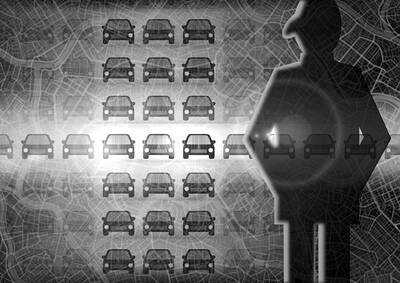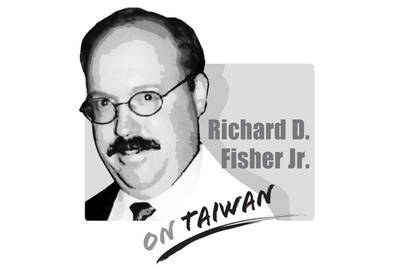Taiwan’s elections, and in particular, its municipal elections, are strongly local; and so while some pundits might wish to read the nine-in-one elections last Saturday from the standpoint of cross-strait relations between Taiwan and China, the reality could not be further from the truth.
Late that night, another commentator and I went by the Chinese Nationalist Party’s (KMT) Taipei headquarters. We arrived just in time to hear KMT Chairman Wu Den-yih’s (吳敦義) final address to the party’s supporters.
Surprisingly, the mood of Wu’s speech was somber and almost apologetic. This seemed strange, because the KMT had just scored resounding victories in the mayoral elections in New Taipei City, Taichung and, in particular, deep-green Kaohsiung.
We had come from the Democratic Progressive Party (DPP) headquarters where President Tsai Ing-wen (蔡英文) had just resigned as party chairperson.
One would have thought that the KMT’s mood would be more festive, if not resoundingly jubilant.
However, after a little thought, the reasons became apparent. Despite those other victories, the KMT was at that moment losing Taipei, its foremost stronghold.
Furthermore, it was losing Taipei, not because of a split in the party ranks, nor because of any tremendous effort by the DPP. Instead, it was losing Taipei to a man independent of both parties, incumbent Mayor Ko Wen-je (柯文哲).
This fact brought out the reality of how elections are local and how many Taiwanese voters do respond to the current winds.
Certainly, some might still try to claim that Taiwan is once again embracing the pro-China KMT party in a great shift. That is not the case. Instead, as Taiwanese continue to discover their newfound democracy, a swing vote is developing.
A simple yet telling question reveals this: “If Taiwanese were making an alleged great KMT shift, why didn’t this happen in Taipei, the very heart of blue territory?”
Once that is answered, the rest easily follows.
The swing vote is most easily seen in Taipei, where Ko defeated KMT challenger Ting Shou-chung (丁守中) by a mere 3,254 votes.
In 2014, Ko had won Taipei with an impressive 853,983 votes; this time he only got 580,820. What happened?
An obvious quick answer would be that this time the DPP, which had supported Ko in 2014, fielded its own candidate, Pasuya Yao (姚文智), who took 244,641 votes from Ko’s count.
However, all things being equal, that would have still left Ko with 609,342 votes. Yet Ko was 28,522 votes short with 580,820.
There is more. In 2014, the so-so KMT candidate Sean Lien (連勝文) received 609,932 votes; but this time, Ting received only 577,566. That was 32,366 votes less than Lien.
It was a beautiful day in Taipei on Saturday; so poor voter turnout due to inclement weather could not be blamed.
Throughout election day, commentators spoke of long lines and a big turnout. They were wrong; the turnout was less. The long lines were there, but they were due to 10 referendums, which not only slowed the voting process, but the vote count as well.
Ko’s victory showed that a substantial independent swing vote is developing not only in Taipei, but throughout the nation. If the DPP had teamed up with Ko this year, he would have won handily, but even without the DPP, Ko still got an amazing 577,566 votes and was able to squeak by.
In analyzing independent swing voters, one finds that for them any previous party loyalty is often replaced by pragmatic, short-term thinking. They ask questions like: “What have you done lately?” “What progress has been made?” “Should I take my vote elsewhere?”
Ko had done enough to retain confidence, and Ting and Yao offered little new.
The KMT victories in New Taipei City, Taichung and Kaohsiung had a different wrinkle.
There the swing vote was not as evident by a three-way split; it is seen more in how much each flipped the vote percentages from the previous election. In each, the KMT candidates also made efforts to distance themselves from the old KMT to attract this swing vote.
In New Taipei City, KMT candidate Hou You-yi (侯友宜) ran more on the strength of his personality than party loyalty. In 2014, incumbent Eric Chu (朱立倫) edged his DPP challenger, Yu Shyi-kun, 50.06 to 48.78 percent, but on Saturday, Hou received 57.15 percent. New Taipei City also added more than 100,000 votes.
In Taichung, where fewer people voted than in 2014, the KMT’s Lu Shiow-yen (盧秀燕) flipped about 14.5 percent of the vote. In 2014, the DPP’s Lin Chia-lung (林佳龍) beat incumbent Jason Hu (胡志強) with 57.06 percent of the vote, but on Saturday, he only got 42.35 percent. He suffered from not having enough visible accomplishments.
In Kaohsiung, the KMT’s Han Kuo-yu (韓國瑜) imitated Taipei’s Ko by saying he was neither blue nor green, but simply for Kaohsiung.
With extravagant promises equivalent to a “chicken in every pot,” and bringing jobs and people back to Kaohsiung, he flipped about 24 percent compared with the 2014 victory of Chen Chu (陳菊) of the DPP.
However, Han also exposed a weakness in swing voting. Swing voters, especially new ones, may unfortunately lack a sense of history, and be too easily swayed by promises and emotion.
After the election Han dredged up an old KMT canard, when he stated that he would establish a committee to explore the so-called “1992 consensus.” He avoided that in the campaign. This set off a flurry of netizens googling “1992 consensus” to understand the person that they had just elected.
The second big takeaway from the elections is how the changes in the referendum law will have a major role in the future.
This year’s elections were the first time that the changes in December last year were introduced. These major changes lowered several passing bars on referendums.
They now need only 1.5 percent of voter signatures (about 280,000 people) to get a topic on the ballot. To pass they need one-quarter of the eligible voters — 4,939,267 votes — to support them, along with the “yes” votes outnumbering the “no” votes. The voting age has also been lowered to 18 years.
This is a vast improvement and freed referendums from their previous birdcage. As a result, this election had 10 referendums, of which seven were approved with about 55 percent participation.
On the downside, the many referendums did complicate the process and exposed procedure areas to be worked out. Voters were told to know the referendums beforehand, but many spent time reading them in the booths. This slowed everything down. As a result, the final vote tabulation finished at about 2:30am the next day.
However, on the plus side, the range of topics is clearly expanded and allows smaller groups to bring their issues to the fore.
Referendums now also add a one-issue element to the elections as they measure the mood of the nation. For this election day, there were five referendums on LGBT-related matters; three on nuclear and coal power, and one each on the name change for the Olympics and a ban of food products from areas affected by the Fukushima Dai-ichi nuclear power plant disaster.
Thus, as voters and special interest groups better understand how to get referendums on the ballot and how to promote them, the Central Election Committee will have to up its game with more stringent rules.
Like it or not, the swing vote and one-issue referendums are here to stay and will be playing a larger role in Taiwan’s future. On this, all parties and even voters must be aware of these changes and adapt with strategic planning.
Jerome Keating is a writer based in Taipei.
Concerns that the US might abandon Taiwan are often overstated. While US President Donald Trump’s handling of Ukraine raised unease in Taiwan, it is crucial to recognize that Taiwan is not Ukraine. Under Trump, the US views Ukraine largely as a European problem, whereas the Indo-Pacific region remains its primary geopolitical focus. Taipei holds immense strategic value for Washington and is unlikely to be treated as a bargaining chip in US-China relations. Trump’s vision of “making America great again” would be directly undermined by any move to abandon Taiwan. Despite the rhetoric of “America First,” the Trump administration understands the necessity of

If you had a vision of the future where China did not dominate the global car industry, you can kiss those dreams goodbye. That is because US President Donald Trump’s promised 25 percent tariff on auto imports takes an ax to the only bits of the emerging electric vehicle (EV) supply chain that are not already dominated by Beijing. The biggest losers when the levies take effect this week would be Japan and South Korea. They account for one-third of the cars imported into the US, and as much as two-thirds of those imported from outside North America. (Mexico and Canada, while

US President Donald Trump’s challenge to domestic American economic-political priorities, and abroad to the global balance of power, are not a threat to the security of Taiwan. Trump’s success can go far to contain the real threat — the Chinese Communist Party’s (CCP) surge to hegemony — while offering expanded defensive opportunities for Taiwan. In a stunning affirmation of the CCP policy of “forceful reunification,” an obscene euphemism for the invasion of Taiwan and the destruction of its democracy, on March 13, 2024, the People’s Liberation Army’s (PLA) used Chinese social media platforms to show the first-time linkage of three new
I have heard people equate the government’s stance on resisting forced unification with China or the conditional reinstatement of the military court system with the rise of the Nazis before World War II. The comparison is absurd. There is no meaningful parallel between the government and Nazi Germany, nor does such a mindset exist within the general public in Taiwan. It is important to remember that the German public bore some responsibility for the horrors of the Holocaust. Post-World War II Germany’s transitional justice efforts were rooted in a national reckoning and introspection. Many Jews were sent to concentration camps not